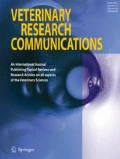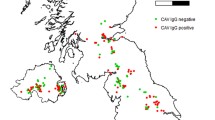Abstract
Canine adenovirus type 1 (CAdV-1) is the aetiological agent of infectious canine hepatitis (ICH) in domestic dogs (Canis familiaris). In spite of the widespread use of vaccination, CAdV-1 continues to circulate in the dog population. Although a high number of serological screenings have indicated that CAdV-1 is widespread in fox species, little is known about the potential role of foxes as reservoirs of CAdV-1. Furthermore, very little data exist on the molecular features of this virus in foxes. To add to existing knowledge on CAdV-1 circulating in wild carnivores, tissue samples from CAdV-seropositive red foxes (Vulpes vulpes, n = 10) from the northern mainland of Norway and arctic foxes (Vulpes lagopus, n = 10) from the Svalbard archipelago, Norway, were investigated using a molecular approach to detect CAdV-1 DNA and important structural and non-structural genes of the detected viruses were sequenced and analysed. Amplicons characteristic for CAdV-1 were amplified from 14 out of 20 foxes (7 red foxes and 7 arctic foxes) and spleen and lymph node tissues resulted optimal targets for the viral DNA detection. The nucleotide sequences showed unique features that distinguished the viruses detected in this study from the CAdV-1 to date identified in wild carnivores and dogs. Greater attention should be given to genetically different CAdV-1 circulating in wild carnivores that may be transferred to dogs, potentially causing disease and reducing the effectiveness of available vaccines.

Similar content being viewed by others
Data availability
The nucleotide sequences obtained have been lodged within the GenBank sequence database under accession numbers: MF344652-MF344677.
References
Akerstedt J, Lillehaug A, Larsen IL, Eide NE, Arnemo JM, Handeland K (2010) Serosurvey for canine distemper virus, canine adenovirus, Leptospira interrogans, and toxoplasma gondii in free-ranging canids in Scandinavia and Svalbard. J Wildl Dis 46:474–480. https://doi.org/10.7589/0090-3558-46.2.474
Balboni A, Verin R, Morandi F, Poli A, Prosperi S, Battilani M (2013) Molecular epidemiology of canine adenovirus type 1 and type 2 in free-ranging red foxes (Vulpes vulpes) in Italy. Vet Microbiol 162:551–557. https://doi.org/10.1016/j.vetmic.2012.11.015
Balboni A, Mollace C, Giunti M, Dondi F, Prosperi S, Battilani M (2014) Investigation of the presence of canine adenovirus (CAdV) in owned dogs in northern Italy. Res Vet Sci 97:631–636. https://doi.org/10.1016/j.rvsc.2014.10.010
Balboni A, Dondi F, Agnoli C, Verin R, Gruarin M, Morini M, Battilani M (2017) Novel sequence variants of viral hexon and fibre genes in two dogs with canine adenovirus type 1-associated disease. Vet J 223:73–75. https://doi.org/10.1016/j.tvjl.2017.05.011
Belsare AV, Gompper ME (2013) Assessing demographic and epidemiologic parameters of rural dog populations in India during mass vaccination campaigns. Prev Vet Med 111:139–146. https://doi.org/10.1016/j.prevetmed.2013.04.003
Caudell D, Confer AW, Fulton RW, Berry A, Saliki JT, Fent GM, Ritchey JW (2005) Diagnosis of infectious canine hepatitis virus (CAV-1) infection in puppies with encephalopathy. J Vet Diagn Investig 17:58–61. https://doi.org/10.1177/104063870501700111
Clifford DL, Mazet JAK, Dubovi EJ, Garcelon DK, Coonan TJ, Conrad PA, Munson L (2006) Pathogen exposure in endangered island fox (Urocyon littoralis) populations: implications for conservation management. Biol Conserv 131:230–243. https://doi.org/10.1016/j.biocon.2006.04.029
Decaro N, Campolo M, Elia G, Buonavoglia D, Colaianni ML, Lorusso A, Mari V, Buonavoglia C (2007) Infectious canine hepatitis: an "old" disease reemerging in Italy. Res Vet Sci 83:269–273. https://doi.org/10.1016/j.rvsc.2006.11.009
Decaro N, Martella V, Buonavoglia C (2008) Canine adenoviruses and herpesvirus. Vet Clin North Am Small Anim Pract 38:799–814. https://doi.org/10.1016/j.cvsm.2008.02.006
Geffen E, Waidyaratne S, Dalén L, Angerbjörn A, Vila C, Hersteinsson P, Fuglei E, White PA, Goltsman M, Kapel CM, Wayne RK (2007) Sea ice occurrence predicts genetic isolation in the Arctic fox. Mol Ecol 16:4241–4255. https://doi.org/10.1111/j.1365-294X.2007.03507.x
Gerhold RW, Allison AB, Temple DL, Chamberlain MJ, Strait KR, Keel MK (2007) Infectious canine hepatitis in a gray fox (Urocyon cinereoargenteus). J Wildl Dis 43:734–736. https://doi.org/10.7589/0090-3558-43.4.734
Greene CE (2012) Infectious canine hepatitis and canine acidophil cell hepatitis. In: Greene CE (ed) Infectious diseases of the dog and cat, 4th edn. Saunders Elsevier, St. Louis, pp 42–48
Gür S, Acar A (2009) A retrospective investigation of canine adenovirus (CAV) infection in adult dogs in Turkey. J S Afr Vet Assoc 80:84–86
Headley SA, Alfieri AA, Fritzen JT, Garcia JL, Weissenböck H, da Silva AP, Bodnar L, Okano W, Alfieri AF (2013) Concomitant canine distemper, infectious canine hepatitis, canine parvoviral enteritis, canine infectious tracheobronchitis, and toxoplasmosis in a puppy. J Vet Diagn Investig 25:129–135. https://doi.org/10.1177/1040638712471344
Hechinger S, Scheffold S, Hamann HP, Zschöck M (2017) Detection of canine adenovirus 1 in red foxes (Vulpes vulpes) and raccoons (Procyon lotor) in Germany with a TaqMan real-time PCR assay. J Vet Diagn Investig 29:741–746. https://doi.org/10.1177/1040638717712331
Henttonen H, Fuglei E, Gower CN, Haukisalmi V, Ims RA, Niemimaa J, Yoccoz NG (2001) Echinococcus multilocularis on Svalbard: introduction of an intermediate host has enabled the local life-cycle. Parasitology 123:547–552. https://doi.org/10.1017/S0031182001008800
Hu RL, Huang G, Qiu W, Zhong ZH, Xia XZ, Yin Z (2001) Detection and differentiation of CAV-1 and CAV-2 by polymerase chain reaction. Vet Res Commun 25:77–84. https://doi.org/10.1023/A:1006417203856
Jameson BA, Wolf H (1988) The antigenic index: a novel algorithm for predicting antigenic determinants. Comput Appl Biosci 4:181–186. https://doi.org/10.1093/bioinformatics/4.1.181
Kozak RA, Ackford JG, Slaine P, Li A, Carman S, Campbell D, Welch MK, Kropinski AM, Nagy É (2015) Characterization of a novel adenovirus isolated from a skunk. Virology 485:16–24. https://doi.org/10.1016/j.virol.2015.06.026
Librado P, Rozas J (2009) DnaSP v5: a software for comprehensive analysis of DNA polymorphism data. Bioinformatics 25:1451–1452. https://doi.org/10.1093/bioinformatics/btp187
Margalit H, Spouge JL, Cornette JL, Cease KB, Delisi C, Berzofsky JA (1987) Prediction of immunodominant helper T cell antigenic sites from the primary sequence. J Immunol 138:2213–2229
McCue PM, O'Farrell TP (1988) Serological survey for selected diseases in the endangered San Joaquin kit fox (Vulpes macrotis mutica). J Wildl Dis 24:274–281. https://doi.org/10.7589/0090-3558-24.2.274
Millán J, López-Bao JV, García EJ, Oleaga Á, Llaneza L, Palacios V, de la Torre A, Rodríguez A, Dubovi EJ, Esperón F (2016) Patterns of exposure of iberian wolves (Canis lupus) to canine viruses in human-dominated landscapes. Ecohealth 13:123–134. https://doi.org/10.1007/s10393-015-1074-8
Mørk T, Bohlin J, Fuglei E, Åsbakk K, Tryland M (2011) Rabies in the arctic fox population, Svalbard, Norway. J Wildl Dis 47:945–957. https://doi.org/10.7589/0090-3558-47.4.945
Morrison MD, Onions DE, Nicolson L (1997) Complete DNA sequence of canine adenovirus type 1. J Gen Virol 78:873–878. https://doi.org/10.1099/0022-1317-78-4-873
Norén K, Statham MJ, Ågren EO, Isomursu M, Flagstad Ø, Eide NE, Berg TB, Bech-Sanderhoff L, Sacks BN (2015) Genetic footprints reveal geographic patterns of expansion in Fennoscandian red foxes. Glob Chang Biol 21:3299–3312. https://doi.org/10.1111/gcb.12922
Pratelli A, Martella V, Elia G, Tempesta M, Guarda F, Capucchio MT, Carmichael LE, Buonavoglia C (2001) Severe enteric disease in an animal shelter associated with dual infections by canine adenovirus type 1 and canine coronavirus. J Vet Med B Infect Dis Vet Public Health 48:385–392. https://doi.org/10.1046/j.1439-0450.2001.00466.x
Robinson AJ, Crerar S, Sharma NW (2005) Prevalence of serum antibodies to canine adenovirus and canine herpesvirus in the European red fox (Vulpes vulpes) in Australia. Aust Vet J 83:356–361. https://doi.org/10.1111/j.1751-0813.2005.tb15634.x
Sette A, Buus S, Appella E, Smith JA, Chesnut R, Miles C, Colon SM, Grey HM (1989) Prediction of major histocompatibility complex binding regions of protein antigens by sequence pattern analysis. Proc Natl Acad Sci U S A 86:3296–3300. https://doi.org/10.1073/pnas.86.9.3296
Thompson H, O’Keeffe AM, Lewis JCM, Stocker LR, Laurenson MK, Philbey AW (2010) Infectious canine hepatitis in red foxes (Vulpes vulpes) in the United Kingdom. Vet Rec 166:111–114. https://doi.org/10.1136/vr.b4763
Truyen U, Müller T, Heidrich R, Tackmann K, Carmichael LE (1998) Survey on viral pathogens in wild red foxes (Vulpes vulpes) in Germany with emphasis on parvoviruses and analysis of a DNA sequence from a red fox parvovirus. Epidemiol Infect 121:433–440. https://doi.org/10.1017/S0950268898001319
Tryland M, Balboni A, Killengren ST, Mørk T, Nielsen O, Yoccoz N, Ims RA, Fuglei E (2018) A screening for canine distemper virus, canine adenovirus and carnivore protoparvoviruses in arctic foxes (Vulpes lagopus) and red foxes (Vulpes vulpes) from arctic and sub-arctic regions of Norway. Polar Res Accepted April 05:2018
Walker D, Fee SA, Hartley G, Learmount J, O'Hagan MJ, Meredith AL, de C Bronsvoort BM, Porphyre T, Sharp CP, Philbey AW (2016) Serological and molecular epidemiology of canine adenovirus type 1 in red foxes (Vulpes vulpes) in the United Kingdom. Sci Rep 6:36051. https://doi.org/10.1038/srep36051
Welling GW, Weijer WJ, van der Zee R, Welling-Wester S (1985) Prediction of sequential antigenic regions in proteins. FEBS Lett 188:215–218. https://doi.org/10.1016/0014-5793(85)80374-4
Woods LW (2001) Adenoviral diseases. In: Williams ES, Barker IK (eds) Infectious diseases of wild mammals, 3rd edn. Iowa State University Press, Ames, pp 202–212
Acknowledgements
We thank all the trappers and hunters that provided the fox samples. Funding for sampling the fox tissues were provided from the Norwegian Polar Institute and financed by the Norwegian Environment Agency to Climate –ecological Observatory for Arctic Tundra (COAT). We also acknowledge Dr. Javier Sánchez Romano for help with the tissue samples and DNA extraction.
Author information
Authors and Affiliations
Corresponding author
Ethics declarations
Conflict of interest
The authors declare that they have no conflict of interest.
Additional information
Publisher’s note
Springer Nature remains neutral with regard to jurisdictional claims in published maps and institutional affiliations.
Electronic supplementary material
Online Resource 1
(PDF 13 kb)
Online Resource 2
(PDF 98 kb)
Online Resource 3
(PDF 70 kb)
Online Resource 4
(PDF 73 kb)
Rights and permissions
About this article
Cite this article
Balboni, A., Tryland, M., Mørk, T. et al. Unique genetic features of canine adenovirus type 1 (CAdV-1) infecting red foxes (Vulpes vulpes) in northern Norway and arctic foxes (Vulpes lagopus) in Svalbard. Vet Res Commun 43, 67–76 (2019). https://doi.org/10.1007/s11259-019-09746-y
Received:
Accepted:
Published:
Issue Date:
DOI: https://doi.org/10.1007/s11259-019-09746-y




